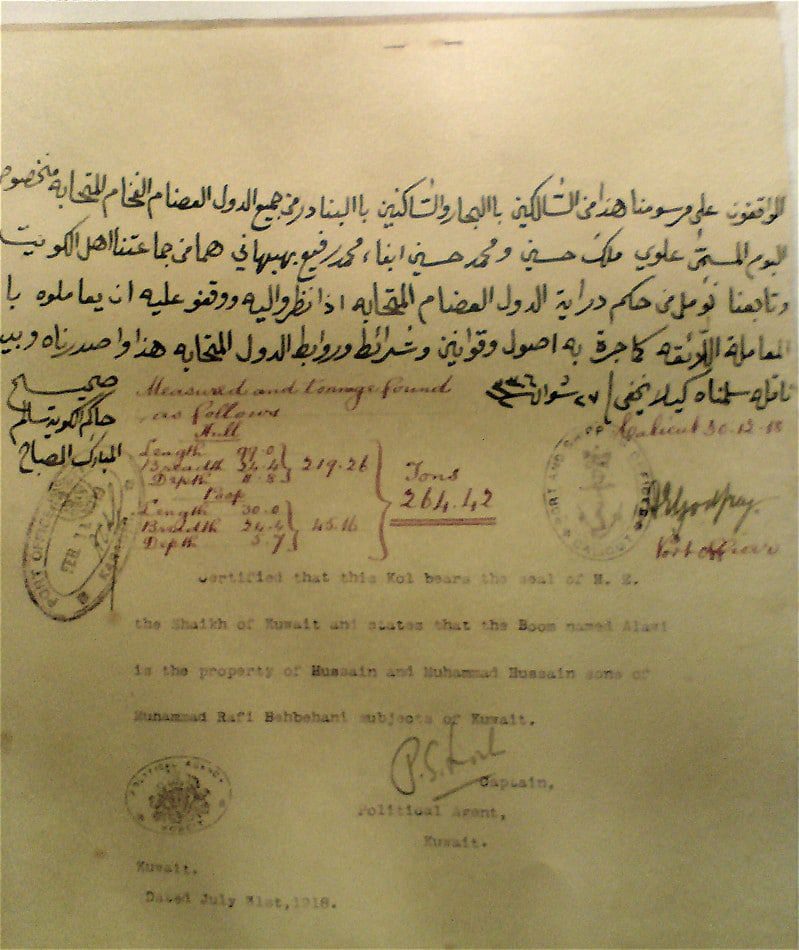The reign of Mubarak Al-Sabah (1896-1915) – Mubarak al-Kabir (the Great), as he came to be known – represents a watershed in Kuwait’s political history. Al-Sabah rule had traditionally been based on a sharp division of roles within Kuwaiti society. The merchants controlled outside trade, especially sea trade, and the pearling industry. The Al-Sabah tribe was responsible for the security and diplomatic contacts with the Bedouin desert tribes and the Ottoman Empire.
The Al-Sabah did not tax the inhabitants of Kuwait directly, and the latter did not consider themselves subjects of the Al-Sabah in a modern sense. The merchant families made their donations to the Al-Sabah rulers in explicit exchange for the political and security services provided by the latter. The Al-Sabah rulers could not force the payment of taxes, and their acceptance as rulers depended in large part on their personal tact and competence.
The traditional Kuwaiti political system based on consensus experienced a violent crisis at the end of the 19th century. In 1896, Mubarak the Great had his two older brothers – the then ruler Muhammad and his confidant Jarrah Al-Sabah – murdered in a violent palace coup. But as a recent scholarly biography of Mubarak the Great points out, nothing is known with certainty about the actual perpetrators and their motives.
One thing, however, is clear: when Mubarak succeeded his slain brother Muhammad, he was supported by the majority of the Al-Sabah, the merchant elite, and the Ottoman military commander in the region. So, the dominant view of ‘the tyrant’ Mubarak, who personally brought an end to Al-Sabah ‘republican’ rule and ruled Kuwait ‘through his slaves’, may have to be modified in the future. Under Mubarak, the threat of absorption by the Ottoman Empire or an invasion by warrior-king Muhammad Ibn Rashid of Arabia was averted. Commerce thrived, and political stability returned.
The advantages of Mubarak’s rule came at a price. In 1899 he signed a secret agreement with the dominant regional power, the British government of India. In this treaty, which was modeled after the treaties the British had concluded earlier with the sheikhdoms of the Lower Gulf, Mubarak transferred his control of Kuwait’s ‘foreign relations’ to the government of India. In return, the British government promised to defend Kuwait against the Ottoman Empire.
The British-Indian backing strengthened the dominant position of Mubarak in Kuwait; what Mubarak really accomplished was thus an exchange of his diplomatic sovereignty for greater domestic manoeuvring space. By cleverly manipulating the international situation – especially the British-Ottoman imperial rivalry and the threat of Muhammad ibn Rashid of Arabia – he was able to gain firm control of Kuwait.
This is evident from the fact that Mubarak in 1899 imposed a customs levy on the merchants and later introduced a series of other new taxes. He used his new resources to finance a rudimentary state administration.
Majlis Movement and British Protectorate

Mubarak’s authoritarian style of rule was continued by his sons, Jaber (r. 1915-1917) and Salim (r. 1917-1921), and his grandson, Ahmad (r. 1921-1950). Throughout this period, the Al-Sabah rulers and the merchants jockeyed for power, with the latter trying to regain their former dominance. Jaber was forced to repeal some of Mubarak’s unpopular taxes, but Salim managed to introduce Kuwait’s first official security apparatus.
When, in 1934, Sheikh Ahmad granted an oil concession to the British-American-controlled Kuwait Oil Company, it assured the ruler of a regular income, in addition to the tax on merchants. The merchants rightly felt that this would further reduce their political influence, leading them to choose from among their ranks Kuwait’s first National Assembly (al-Majlis al-Watani) to counter growing Al-Sabah power.
But the Majlis Movement of 1938 faltered on account of its lack of unity, its generally pro-Iraqi stance, and the withdrawal of Britain’s initial support. The Al-Sabah then divided control of all fledgling government departments – some of them set up by the Majlis – among its senior members. The Gulf region’s first dynastic monarchy was born.
After World War I, which had brought about the collapse of the Ottoman Empire, Britain tightened further its grip on Kuwait. With the last traces of nominal Ottoman sovereignty removed, the sheikhdom became a British protectorate. At the eastern Arabian port of Uqair in 1922, Kuwait, the new British-controlled Kingdom of Iraq, and Abdulaziz Saud (Ibn Saud) of Najd were supposed to resolve their territorial conflicts and delineate their mutual boundaries.
Both the Sheikh of Kuwait and the King of Iraq were represented by a British colonial official. Underlining the geopolitical realities of the day, Sir Percy Cox, the British High Commissioner in Baghdad, at Uqair handed over two-thirds of Kuwait’s claimed territory to Ibn Saud, the future founder of Saudi Arabia.
The Kuwaitis were in no position to protest: Percy Cox might very well have incorporated Kuwait into the new state of Iraq, or just as threatening, he might have left the sheikhdom unprotected from the fierce (Wahhabi) Ikhwan, the militiamen of Ibn Saud.
[/vc_column_text][/vc_column][/vc_row]

